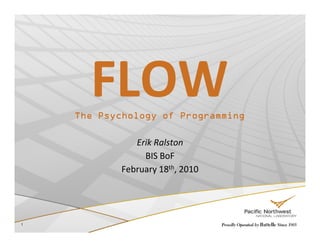
Flow
- 1. FLOW The Psychology of Programming Erik Ralston BIS BoF February 18th, 2010 1
- 3. What is Flow? A psychological state of high performance concentration Often experienced during applied creativity (art, music, programming) Generally a “happy” or “ecstatic” state for the participant Identified by Mihaly Csíkszentmihályi (me-HIGH chick-sent-me-HIGH-ee) Characterized by absentmindedness Merging of action and awareness Narrowing of external perception Loss of time perception 3
- 4. Who uses flow? Athletes – Sports psychology is about combining mental and physical technique to achieve flow. 4
- 5. Who uses flow? Musicians – Sight-reading and improvisational performance rely on merged thought and action. 5
- 6. Who uses flow? Game Designers – Flow provides the positive emotions associated with game experiences. 6
- 7. Who uses flow? Martial Artists – Mushin – “No Mind” – Chinese word for zen- like mental state in combat and practice 7
- 8. What is like FLOW (but not)? Fascination – The total perception of only a single stimulus 8
- 9. What is like FLOW (but not)? Highway Hypnosis – The mental state achieved during driving (or other tasks) releasing the conscious mind from repetition 9
- 10. What is like FLOW (but not)? Mania – A psychotic state of racing thought Stems from dysfunction in the brain Bi-Polar patients “enjoy” mania Manic individuals often stop taking drugs in order to return to “the high” 10
- 11. How do I “Use The FLOW”? To a certain extent, flow is about overwhelming the mind Immersive – Activity must be intense and multi-faceted Automaticity – Details of actions are sub-conscious Instant Gratification – Feedback is immediate Incremental progress is immediately perceptible Familiarity – Do it using a language & technology you know Comfort – Good ergonomics, personalized surroundings, and full stomach Listen to music 11
- 14. Flow Channel & Learning 14
- 15. What stops FLOW? Confusion (No Control) - I don’t know why or what I am doing Coercion (No Control) – I don’t WANT to do what I’m doing Frustration (No Rewards) – What I do doesn’t help! Boredom (No Challenge) – One tunes out during menial tasks, they don’t flow! 15
- 16. How does FLOW help programming? Connects coding to happiness; making it exciting not boring Integrates thinking and coding into one mental process Allows intuitive parts of brain to manage complexity 16
- 17. Addicted to Flow Flow causes “workaholics” and video game addiction Drugs seek to replicate what Flow does naturally Do not choose Flow instead of life 17
- 18. How does PNNL promote FLOW? Policies for employee engagement Control - “At work, do your opinions seem to count” Challenge - “In the last year, have you had opportunities to learn and grow?” Reward (Extrinsic) – “In the last seven days, have you received recognition or praise for doing good work?” Reward (Intrinsic) - “At work, do you have the opportunity to do what you do best every day?” 18
- 19. Questions? 19
- 20. THANK YOU! And May The Flow Be With You 20
